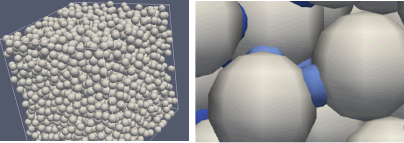
Elasticity of model weakly cemented granular materials: a numerical study
- Post by: olivier.pitois
- 24 December 2020
- No Comment
International Journal of Solids and Structures, 2020, 193-194, pp.13-27
Elasticity of model weakly cemented granular materials: a numerical study.
Alexandros Theocharis, Jean-Noël Roux and Vincent Langlois
Abstract: The effect of bonding cementation on the elastic properties of model granular materials is investigated by grain-level numerical simulations. Two different morphologies are studied, bridging cementation, for which the cement concentrates in cylindrical connections, with radius a, between contacting or neighboring grains separated by a distance smaller than a certain range h0; and grain coating, for which a cement layer with uniform thickness Δ forms on grain surfaces. Cementation is applied to spherical ball packs assembled by the discrete element method (DEM) in different isotropic states throughout the range of mechanically accessible structures, with different densities and contact connectivities. The determination of the elastic properties of the cemented material is a two stage procedure, in which (i) bond stiffnesses, and (ii) macroscopic moduli of large bond networks, are successively computed. Our treatment of stage (i) is based on a previously published model (V. Langlois, International Journal of Numerical and Analytical Methods in Geomechanics, 39(8), p. 854, 2015 (Langlois, 2015)), suitably generalized to deal with prestressed granular materials in which contacts carry a certain force prior to cementation, and with distant bonding. In stage (ii), different initial packs are compared, and the influence of the model parameters (a, h0, Δ) is discussed. The angular elasticity of cemented bonds, for bridging cementation, may influence the macroscopic moduli for small bond coordination number and large enough bond radii, but does not affect grain-coated cemented materials. Macroscopic moduli are essentially determined by the average bond stiffness and by the bond network coordination number. Large confining stresses prior to cementation tend to stiffen the cemented material. The limit of stiff cement is shown to apply in a restricted range. As for unbonded grains, the Voigt approximation scheme for elastic moduli gives fair predictions for the bulk modulus, but rather poor ones for the shear modulus, in weakly coordinated systems. The scheme advocated by Dvorkin and Nur (Geophysics, 61(5), p. 1363, 1996 (Dvorkin and Nur, 1996)), often used in geomechanics, relies on the Voigt approximation. Though yielding correct orders of magnitude, it can be inaccurate, as it does not account for the cement content dependence of coordination numbers.
https://doi.org/10.1016/j.ijsolstr.2020.02.005

